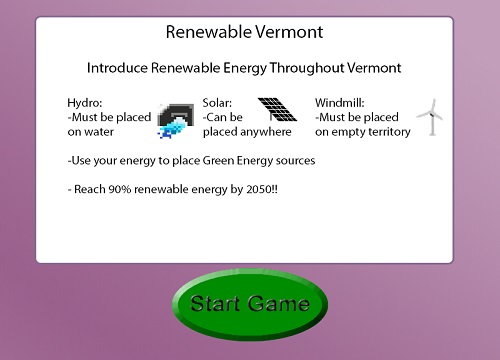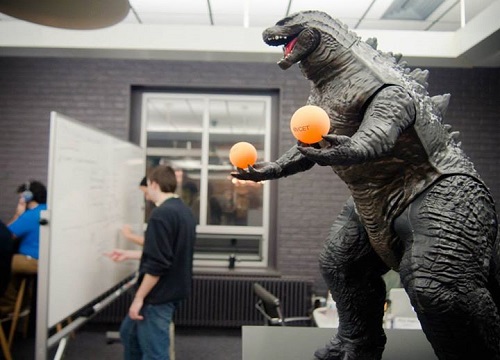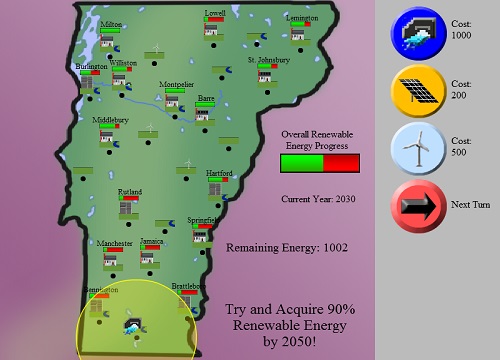
Project Title: Vermont Hackathon: Renewable Vermont
Development: ActionScript 3.0
My Role: Gameplay Programmer, Designer
Designers: Evan Schipellite, Paul Kubik
Artist: Paul Kubik
Programmers: Matt Struble, Jake Ellenberg, Paul Kubik, Evan Schipellite
Award: Best Student Application, Vermont Hackathon 2014


The Vermont Hackathon, or HackVT, was a 24-hour coding event that was held in the VCET @ BTV space in Burlington, Vermont. The over-arching goal of the code jam was for teams of developers to challenge themselves to create unique and innovative applications utilizing provided APis and Data. At HackVT 2014, the theme of the challenge related to renewable energy, and how various collections of information from energy sources could be combined to further support Vermont.
Working alongside Matt Struble, Jake Ellenberg, and Paul Kubik; we formed a student team known as the Pile Party, figuring we would continue the legacy set by one of our past Professors, John Pile Jr., who had previously won HackVT a few years beforehand. We scheduled a meeting a few days before the event, and we reviewed some of the information provided, ultimately deciding that it would be best if we made use of our game development skills and created an educational game based on renewable energy.
When we were arrived at the event, we were directed to a very nice corner area that would enable to us to spread our laptops over a large table and utilize a few different whiteboards for designing the game. Matt and Jake were quickly tasked with researching the process for acquiring all of the data we needed, while Paul and I began designing the actual gameplay and structure. We decided to focus the game on the portrayal of three of the major energy sources in Vermont: solar arrays, wind farms, and hydro generators. The goal of the game would revolve around discussing the physical positioning of energy sources and the eventual payback on their returns.
After designing the majority of the gameplay, I began creating the actual foundation of the game systems, while Paul started to create some art assets for the towns, cities, and energy units. By researching Vermont's cities, towns, and river locations, I was able to create a simple file system that would enable us to position a number of locations on the map of Vermont, allowing us to concentrate on some of the well-known locations and use terrain within our game's mechanics. After I had completed the base system, Matt, Jake, and I began working on creating some of the game's features that would bring in the data they had collected.

Evan Schipellite and Paul Kubik designing the game
Image Credit: Vermont Hackathon

After approximately twelve hours, the core systems were mostly in place. At that point, it was primarily just a matter of implementing the game flow and turn procedures, which wouldn not be difficult given a simple state handler to navigate between the start screen, gameplay, and end screen. It was definitely important that we completed the majority of the game in half the allotted time, simply because by three in the morning, we had lost a bit of our attentiveness as the hours waned on. It wasn't so much a matter of being unable to continue, but the inability to effectively structure, program, and resolve bugs once we were hitting our limits.
By nine in the morning, the game was pretty much complete. Aside from tuning some values, fixing a few visual bugs, and testing it out on a website, there was not much else to do aside from waiting for the presentations. Originally, we wanted to have an event mechanic that would occur at the start of each turn, therefore introducing external factors to influence gameplay. These would ideally be based on real events and aspects of renewable energy in Vermont, therefore further adding to the educational content. However, given the limit of time and our tired state of minds, we deemed it better to wrap up the project, as that aspect would require additional research and content validation.
By the time teams were beginning presentations, it was clear everyone was pretty much at their limits as well. Depending on which members acquired any amount of sleep, it became apparent that simply portraying the main purpose and goals of the application was the best plan to pursue when presenting, as the limit of time would prevent teams from trying to go into too much detail. Our team quickly presented our game idea, gameplay, and Matt discussed some of the ways we utilized the data sets to assist with how mechanics were created.
The following hours mostly involved packing up and simply talking with other teams while results were finalized. Talking with others was crucial in ensuring that we all didn't nod-off in the midst of the commotion. When results were given, we were definitely ecstatic when we heard that Pile Party was being called up for the student award. We had worked hard on our application and joked about trying to win, but in some ways it was just a far-off hope, so that feeling of actually heading to the main stage with the team was amazing. Most of the later parts of that day were a blur, heading up to the stage, holding the check, getting our pictures taken. But it was definitely an awesome experience, and it was also great to eventually go home and sleep, knowing that Pile Party had won a great success.

Pile Party's award for Best Student Application
Image Credit: Matt Struble